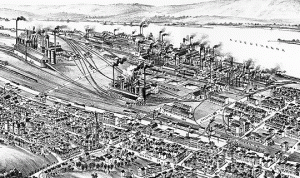
Steelton, Pennsylvania
Steelton served as an opportune fieldwork site for the American Mosaic because of its rich racial and ethnic diversity, its economic history, and its genuine charm. It is also a short drive (about a half-hour) from the Dickinson College campus. On a map of the greater Harrisburg area, Steelton’s shaded representation is long and thin, stretching a short distance of the Susquehanna River. Driving down Front Street, the community’s main drag, the length of Steelton seems determined by the Pennsylvania Steel Technologies works that dominate the banks of the river. In fact, the steel works have controlled much of Steelton’s history, right down to the source of its name. When the steel mill was erected, the stretch of land was named Steel City; that name eventually evolved into the proper title, Steelton.: “tons of steel.” Before the works were built in 1866, the undeveloped land housed only six families. In the heyday of the steel industry, it was ho me to over 16,000 residents, representing 33 different ethnic groups. With increasing de-industrialization and the closing down of many of the steel mill ‘s operations, the population has declined to 5,162 people.
The Steelton plant was the first mill in the United States dedicated exclusively to the process of making steel. Its construction in 1866 and the growth of the industry drew a diverse, immigrant workforce from England, Ireland, Germany, Italy, Eastern Europe, and Mexico in the late 19th and early 20th centuries. A large black population migrated from the southern United States during this period as well. Both job categories in the mill and the residential neighborhoods were segregated by ethnic group. Each culture established their own places of worship and social organizations to strengthen kinship ties and maintain a sense of connection to their homeland.
Today, ethnic neighborhoods are less distinct and the five Catholic churches that once were strongly ethnically identified have been merged. Steelton has remained a largely working-class community, with most of its residents entering into the workforce immediately after high school. According to the 1993 Dauphin County Data Book, only 10% of the population holds a college degree. Consistent with education levels, in 1989, the median income of households was $28,181.
A number of businesses and service agencies operate on and around Front Street. Chain stores such as Turkey Hill Mini-Market and the Rite Aid Pharmacy coexist with small family-owned enterprises such as Fromm’s Uniforms and Mike’s Shoe Repair. In many ways, the downtown area with its small shops and ten-cent parking meters, seems frozen in another era. However, Steelton’s newest enterprise, the Divine Light New Age Bookstore, clearly demonstrates otherwise.
Front Street is also the town’s social center, where the employees of Pennsylvania Steel Technologies can stop for a drink, and gather at fraternal organizations such as the Moose and Masonic Lodges or the VFW building. Churches, in the residential areas, provide a force which binds the citizens and eases the sense of insecurity which looms within the Steelton plant. Though the downsizing of the mill may continue, the diverse-yet-cohesive Steelton community continues to survive, seemingly as resilient as t he steel rail they produce.
Postcards from the collection of Steelton local Historian and collector Harold Kerns
Born in 1921, Mr. Kerns was raised in the “Westside” section of Steelton. The Westside was home to many working class Irish, Croatian, Hungarian, and African Americans. He graduated from Steelton High School in 1939. From October 3rd until his retirement on February 1st 1983, Mr. Kerns worked as a highly skilled machinist at the steel mill in Steelton. Working within thousandth of inch tolerances, Mr. Kerns and his colleagues made raw steel and then fabricated and machined raw steel into finely-honed line shafts and gears for World War II battleships, structural elements for the Golden Gate Bridge, frog-switches and rail for every major railroad in the country. These men and women are the unsung heroes of our American material culture. Mr. Kerns was active in the organization of the steel workers union which brought for the first time in a century, a measure of dignity and security to steel workers and their families.
With a deep love of Steelton, its people, and history, Mr. Kerns has been collecting memorabilia, documents, artifacts, and photographs most of his life. His collection and knowledge of Steelton history is extensive. In collaboration with the late John Yetter, who was also a local machinist-historian, Mr. Kerns produced the photo history Stop, Look, and Listen: A History of Steelton, PA, published in 1980. Mr. Kerns and his wife, Sue Duke Kerns, currently live in Enhaut, a small community adjacent to Steelton.
The American Mosaic Semester faculty and students are deeply grateful for the many hours Harold Kerns spent sharing his knowledge of the people of Steelton and for sharing so much of himself in the process.
Go Back to the American Mosaic Homepage